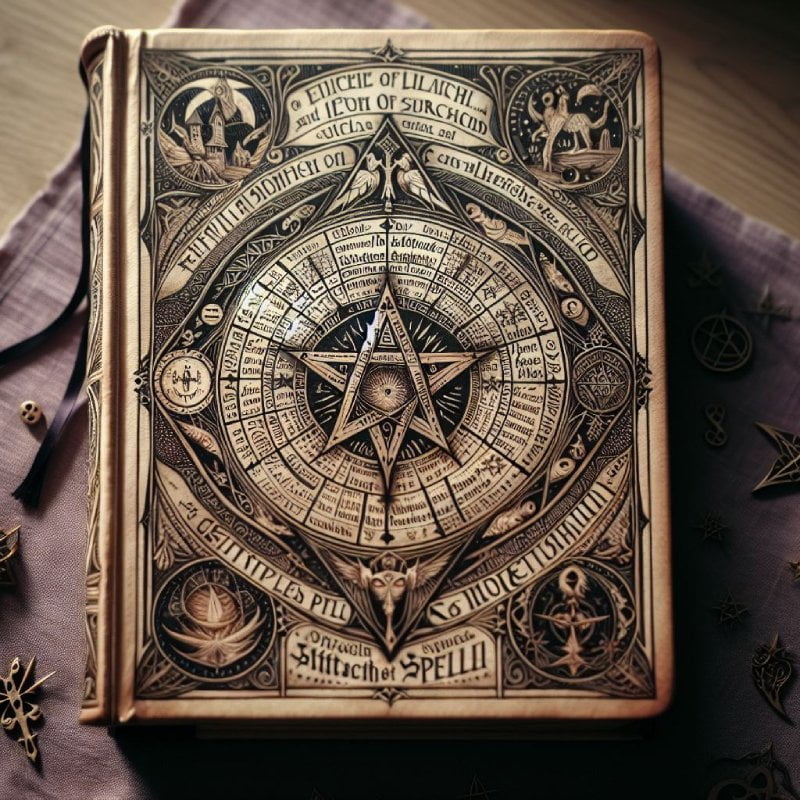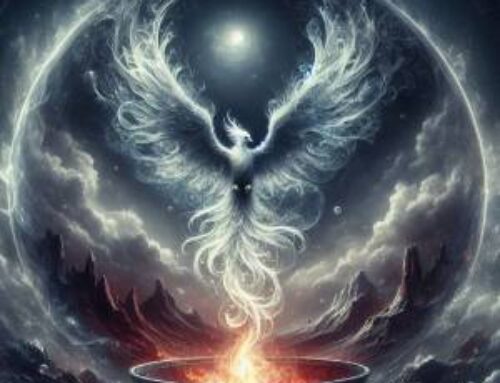Contents
- 1
- 2 Introduction to Black and White Magick
- 3 The Realms of Black and White Magick
- 4 The Philosophical Underpinnings of Magick
- 5 Practical Applications and Misconceptions of Black and White Magick
- 6 Conclusion
- 7 FAQ – Black and White Magick
- 7.1 1. Why is black magick considered evil in many esoteric traditions?
- 7.2 2. Can practicing black magick lead to spiritual enlightenment?
- 7.3 3. How does white magick contribute to a practitioner’s spiritual development?
- 7.4 4. What are the ethical implications of choosing between black and white magick?
- 7.5 5. Where can I study authentic magick practices, including the ethical use of white magick?
- 8 References:
Introduction to Black and White Magick
In the enigmatic world of esoteric practices, the distinction between “magick” and “magic” is not merely typographical but deeply symbolic. The term “magick,” preferred and popularized by the influential occultist Aleister Crowley, signifies more than mere illusion or sleight of hand associated with stage “magic.” Instead, it refers to the profound manipulation of the metaphysical energies and the harnessing of the universe’s hidden forces according to one’s will.

Among the varied paths of magick, the concepts of black and white magick stand as pivotal categories, guiding the intentions and methods of practitioners (1). Black magick, often misunderstood, aligns with the Left-Hand Path, a route not of malevolence as popular culture might suggest, but of involution. It is a path seeking personal empowerment, embracing the material aspects of existence, and challenging the conventional ethical boundaries to transform one’s reality.
Conversely, white magick, associated with the Right-Hand Path, focuses on the evolution of the spirit, promoting healing, benevolence, and a harmonious balance with the universal laws. This duality in magick does imply represents a spectrum of approaches to the mystical and the mysterious energies that pervade our world.
As we delve deeper into the realms of black and white magick, we uncover not only the practices and philosophies that define them but also the personal journeys of those who walk these paths, constantly navigating the delicate balance between power and purpose.
The Realms of Black and White Magick
Understanding Black Magick
Black magick, associated with the Left-Hand Path, focuses on personal empowerment and self-advancement. This path emphasizes using magick to alter one’s personal circumstances and environment directly. It is often branded as selfish, as practitioners prioritize their own desires, possibly at the cost of others. Key practices within black magick might involve summoning entities or manipulating energies for personal gain, encapsulating a philosophy that champions individualism over collective moral norms.
Exploring White Magick
In contrast, white magick aligns with the Right-Hand Path, which upholds values of altruism and spiritual growth. Practitioners of white magick use their abilities for healing, protection, and promoting positive energies. This path is characterized by efforts to align one’s actions with universal laws and the greater good, often incorporating rituals that aim at spiritual enlightenment and aiding others. White magick is typically viewed as a benevolent practice, focusing on communal well-being and ethical conduct.
The Philosophical Underpinnings of Magick
Magickal Dualism: Clarifying Misconceptions
The division between black and white magick not only delineates methods and intentions but also underscores profound philosophical differences regarding human capabilities and the nature of reality. Black magick is often understood as merely malicious or evil. However, at its core, it is fundamentally materialistic and represents a limitation—it binds the practitioner to the elemental, physical aspects of existence without transcending them. This path is marked by a belief in the supremacy of personal will and the manipulation of the environment to serve individual goals, often neglecting the spiritual dimensions and consequences.
White Magick: Ascent to Unity
In stark contrast, white magick recognizes the spirit as the ultimate source of all elemental forces. Practitioners of white magick work with the understanding that aligning with the higher self—our true spiritual essence—provides mastery over the material plane, not through subjugation or dominance, but through harmony and integration.
This path is about achieving union with the higher self, fostering enlightenment, and transcending the ego. White magick is driven by the pursuit of universal good and spiritual elevation, often involving rituals and practices that aim to heal, protect, and uplift the collective consciousness.
„Magic[k] is the science of the ancient magi; and the Christian religion… revere those mystic kings who came from the East led by a star to adore the Saviour of the world in His cradle” (2).
Ego vs. Enlightenment
Black magick’s focus on the ego-driven path can lead to a misconception about the true capacities of humans. By prioritizing the ego, practitioners may gain temporary material or psychic powers but often at the cost of true spiritual progress and ethical integrity. In contrast, white magick promotes the dissolution of the ego, recognizing that true power and understanding come from the union with one’s higher self, thus fostering a path that leads to enlightenment and a profound understanding of the interconnectedness of all things.
“All things are from One and by the One; and unto One all things are made“ (3).
Practical Applications and Misconceptions of Black and White Magick
Misconceptions and Human Capacities
The realm of magick is often clouded by misconceptions, particularly about the nature and purpose of black magick. Contrary to popular belief, black magick is not solely a practice of malevolent spells or curses but rather a manifestation of the Left-Hand Path, which emphasizes material and personal gain over spiritual ascendancy. This path is intrinsically linked to the elemental nature, and its practitioners are often seen as being in service to these base energies rather than mastering them. The misconception lies in the belief that black magick can lead to true power or enlightenment, whereas it essentially binds the practitioner to the material plane, perpetuating the illusion of separation from the divine source .
The Enlightened Path of White Magick
In contrast, white magick is rooted in the Right-Hand Path, known for its alignment with spiritual laws and higher universal truths. Practitioners of white magick use their abilities to transcend the physical and connect with their higher selves, achieving a union that enhances their spiritual authority and mastery over the elemental forces. This path recognizes the spirit as the source of all elemental phenomena, establishing dominion through spiritual alignment rather than force or manipulation. White magick is thus seen as a journey toward enlightenment, where the ultimate goal is the harmonious integration with the divine, transcending the ego and its desires .
Practical Implications in Modern Magick
Today, these paths of magick are not just theoretical but are practiced with tangible impacts. Black magick, while often maligned, can be used responsibly under certain ethical frameworks to achieve personal change or influence physical conditions. However, it remains crucial for practitioners to remain vigilant about the spiritual pitfalls associated with this path. White magick continues to be a force for initiation, healing, enlightenment, and spiritual elevation, widely utilized in modern esoteric practices for the betterment of humanity and the pursuit of personal spiritual goals.
Conclusion
In our exploration of black and white magick, we have delineated two distinct paths that offer contrasting approaches to power, self-realization, and spiritual integrity. White magick emerges as a conduit for higher spiritual alignment and enlightenment, urging practitioners to harmonize with universal laws and the greater good. It represents a path of healing, protection, and altruistic intentions, guiding individuals towards unity with the higher self and transcending the limitations of the material world.
Conversely, black magick underscores a profound cautionary tale about the seductions of power and the perils of over-identification with the ego and material desires. It serves as a reminder of the potential spiritual stagnation and ethical pitfalls that can ensue from prioritizing personal gain over collective harmony. This path, deeply rooted in the material realm, often leads to a disconnection from the spiritual sources of true power and wisdom.
As seekers on the esoteric journey, it is crucial to recognize the profound responsibilities that come with wielding magical knowledge. The choice between black and white magick is not merely one of preference but a foundational decision that shapes one’s spiritual trajectory and ethical landscape. For those drawn to the mystic arts, the challenge remains to pursue a path that not only seeks to transform the world around us but also elevates our inner spiritual state, fostering a legacy of wisdom, compassion, and enlightenment. Most of the so-called spiritual societies follow the left path because they are not enlightened and mislead their students to an ego-driven path, even those with magickal exercises, such as Franz Bardon, are in reality a black magick path, since the seeker has no progress, since such techniques are useless and without real initiation in a Mystery School it is a blind path of ego inflation.
Enter the Path of Light
If you are interested in these subjects, the most effective way is to get in touch with an authentic mystery school, such as the Hermetic Academy, which not only preserves initiations and a training system, but is also a living testimony of adepts and masters of the high art of magick.
FAQ – Black and White Magick
1. Why is black magick considered evil in many esoteric traditions?
A: Black magick is often considered evil because it primarily focuses on self-interest and the manipulation of energies to achieve personal gain, frequently at the expense of others’ well-being or ethical standards. This path is associated with the Left-Hand Path, which involves practices that can lead to moral degradation and spiritual corruption, as it encourages practitioners to prioritize their desires over communal harmony and spiritual laws.
2. Can practicing black magick lead to spiritual enlightenment?
A: Practicing black magick typically does not lead to spiritual enlightenment as understood within many spiritual traditions. Since it emphasizes material gains and power over spiritual growth, it often binds practitioners to lower vibrational states, keeping them entangled in ego-driven goals and detached from the higher, altruistic pursuits that characterize spiritual enlightenment.
3. How does white magick contribute to a practitioner’s spiritual development?
A: White magick aligns with the Right-Hand Path, focusing on healing, protection, and the promotion of positive energies that benefit all beings. Practitioners of white magick seek to align their actions with universal laws and work towards spiritual enlightenment. This path promotes initiation, enlightenment, selflessness, healing, and the dissolution of the ego, facilitating a deeper connection with the divine and advancing the practitioner’s spiritual evolution.
4. What are the ethical implications of choosing between black and white magick?
A: Choosing between black and white magick involves significant ethical considerations. White magick is rooted in ethical practices that aim to uplift and harmonize with the universal order, often seen as morally positive. On the other hand, black magick can lead to ethical dilemmas due to its focus on personal desires, potentially causing harm or manipulating others, which is why it is often viewed with caution and considered problematic from a moral standpoint.
5. Where can I study authentic magick practices, including the ethical use of white magick?
A: For those seeking to delve into authentic magickal practices with a focus on ethical applications and spiritual enlightenment, the Hermetic Academy is an excellent place to study. The Academy offers courses and initiations into both the theoretical and practical aspects of magick, emphasizing a balanced approach that aligns with universal laws and the pursuit of spiritual growth.
References:
(1) Rubenstein, E. (2023). Magic: The Legacy of the Rosicrucians. Hermetic World, Paphos.
(2) Eliphas, L. (1854). Dogme et Rituel de la Haute Magie. Paris.
(3) Ficino, M. (1471). Corpus Hermeticum. Florenz.





